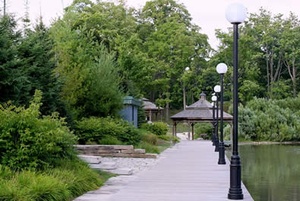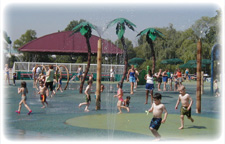 On September 1, 1890 the Village of Waterloo, with the assistance of the Board of Trade, acquired the 65-acre Jacob Eby farm to create its first park. Originally named West Side Park, the site contained the Eby farmhouse and orchard that was prominently located on a knoll which sloped south towards Silver Lake.
On September 1, 1890 the Village of Waterloo, with the assistance of the Board of Trade, acquired the 65-acre Jacob Eby farm to create its first park. Originally named West Side Park, the site contained the Eby farmhouse and orchard that was prominently located on a knoll which sloped south towards Silver Lake.
Shortly after opening, a grandstand was erected to accommodate organized activities at the track, known as the "Oval" and in 1895 over 10,000 visitors enjoyed the Canadian Wheelman’s Association Championship cycling races. Other buildings were added as the park developed, including boat houses and swimming rafts on Silver Lake, the 1820 log school, a band stand, rustic gates and shelter at the mineral spring, and the grass tennis courts in 1900. By 1919 a pavilion, green house, wading pool, washroom and toboggan slide had been added. In early 1920, the Seagram family donated a band shell to the Park in the location of the present Lion’s Lagoon. Change houses, located on either side of the band shell and attached to it, allowed the visitor to enter directly into Silver Lake.
In 1901 citizens of Waterloo raised money to erect a Victoria Jubilee Gateway at the park entrance on Young Street. The gates consisted of India limestone, brickwork, and ornamental ironwork that were illuminated by nine electric globe ornamental lights. This was the only lighting in the Park until the late 1940s when a lighted sports field was constructed.
Throughout its long history the park has been well used by local residents for family reunions, corporate and church picnics, and was a popular attraction for all visitors to Waterloo. Organized music events, such as Saengerfests and Waterloo Music Society Band concerts, were held in the park and attracted thousands of visitors from all over North America.
In the 1950s new buildings were added to the Park including Lion’s Pool and the Park Inn concession stand. Most of the original buildings, with the exception of the Eby Farmhouse and the small cookhouse, were removed during this period - the grandstand in 1953, the gates in 1957, the bandshell in 1969 and the pavilion in 1972. Canada’s centennial in 1967 was celebrated in the Park with the construction of a bandshell in the expanded west side of the Park and the popular animal display area on the east side. In 1996 the rehabilitation of Silver Lake included the addition of a reconstruction of Abraham Erb’s gristmill.
Today Waterloo Park contains a range of facilities, which reflect the different styles, and period of construction in its long history.
Waterloo's premier park, Waterloo Park, is located in the Uptown core of Waterloo and boasts 111 acres of prime parkland with facilities for active and passive recreation. Waterloo Park offers areas for corporate outings, intimate gatherings, weddings, and special events.
- Picnics
- Splash Park
- Eby Farm stead
- Weddings
- Sports
- Restaurant
- Dog Walking
- Skateboarding & BMX
- Festivals


